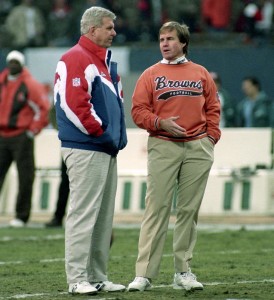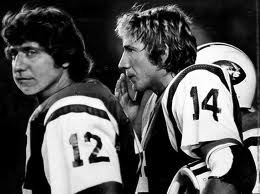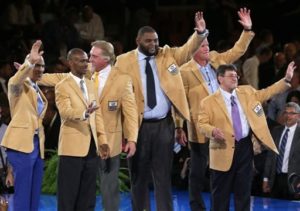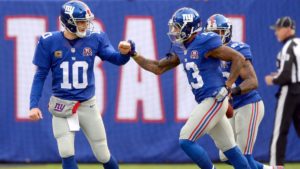
Galbreath with the Saints
Throughout his playing career,
Walter Payton was chasing the ghost of
Jim Brown. At the end of the 1981 season, Payton was in 5th place on the career rushing list. By ’82, he was in 4th; after ’83, he was up to 3rd place. Then, in 1984, Payton passed both Francos Harris and Brown to move into the top spot on the career rushing yards list.
But at the same time that he was chasing a much more flesh-and-blood figure: Saints/Vikings/Giants running back Tony Galbreath. Let’s jump in a time machine back to 1982. At that time, just seven players had at least 75+ career rushing attempts and 375+ career receptions. Three were Hall of Famers Bobby Mitchell, Charley Taylor, and Elroy Hirsch, but all three players made the HOF in large part because of their work as wide receivers. All three players entered professional football as running backs.
Crazy Legs switched after four years (and just one with the Rams) to become a wide receiver on the high-flying Rams of the early ’50s. Taylor was a running back his first two seasons — and a Pro Bowl one at that — but switched positions midway through the 1966 season and remained at wide receiver the rest of his career. Mitchell was stuck behind Brown in Cleveland, but it wasn’t until he was traded to Washington after his fourth season that he become a receiver.
A fourth member of the 75/475 list was Bobby Joe Conrad. who played with the Cardinals in the ’60s. He also switched positions early in his career, and turned into a star receiver almost immediately. As a result, only three true running backs were on the list: Lydell Mitchell, Rickey Young, and Joe Morrison. A star with the Giants in the ’60s, Morrison retired in 1972; he was still the career leader in receptions by a running back a decade later, with 395 receptions. Mitchell, a borderline HOF running back with the Colts, got up to 376 before retiring. Through age 29, he had 355 receptions and had topped 55 catches in each of his last five years; while he would have seemed like a lock to break Morrison’s record, he caught just two more passes the rest of his career.
That leaves Young, a fullback with the Chargers and Vikings. He caught a league-high 88 passes in ’78, and was at 387 receptions as of 1982. He turned 30 in 1983, his final season in the NFL, but caught another 21 passes, breaking Morrison’s record and retiring as the running back catch king, with 408 grabs. But Morrison didn’t retire with an easy stomach: both Payton and Galbreath were hot on his tails.
As of 1983, Payton, who entered the league in 1975, had 328 receptions. But Galbreath was already at 364 receptions, despite entering the NFL a year later. In ’84, Galbreath became just the second pure running back to hit the 400-catch mark; by ’85, Payton had become the third, and Galbreath had supplanted Morrison as the running back catch king. After ’86, Payton had really narrowed the gap: he had 459 career receptions, while Galbreath was at 464. Who would win up as the all-time running back catch king? That left the 1987 season as the battle ground for the highest of stakes: both Payton and Galbreath would retire after the season.
In the season opener, the duo squared off, with all eyes watching the race with a secondary battle between the Giants and Bears taking place. Payton caught three passes, giving him 462 for his career; Galbreath had just one, upping his total to 465.
By November 8th, Payton had closed the gap entirely: both players stood with 475 career receptions. The next week, Payton had a Pyrrhic victory: his Bears lost in Denver, but he became the running back catch king with the first of his three receptions that day (Galbreath had none). [continue reading…]








